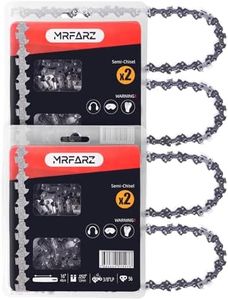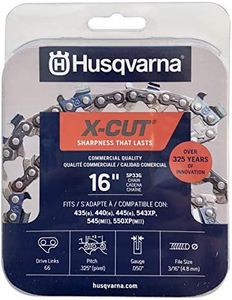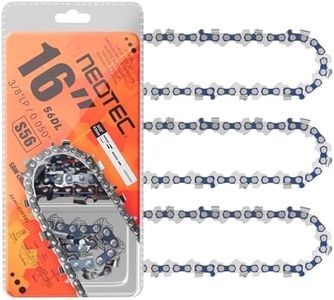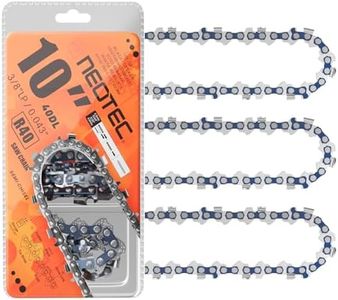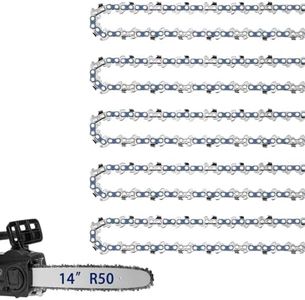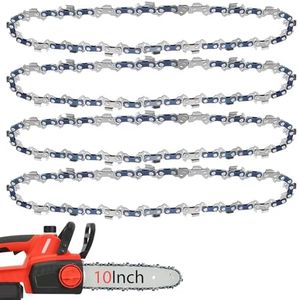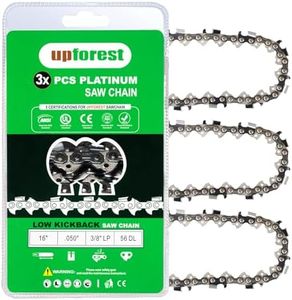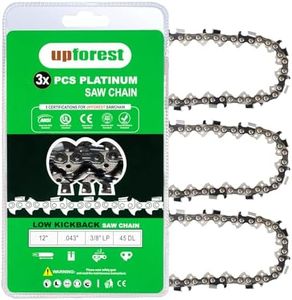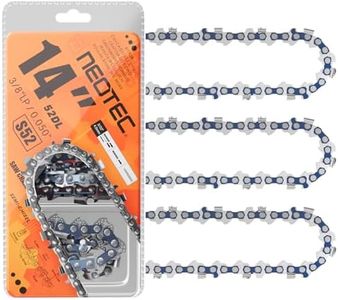We Use CookiesWe use cookies to enhance the security, performance,
functionality and for analytical and promotional activities. By continuing to browse this site you
are agreeing to our privacy policy
10 Best Chain Saw Chains
From leading brands and best sellers available on the web.Buying Guide for the Best Chain Saw Chains
Choosing the right chain for your chainsaw is essential for safety, efficiency, and proper functioning of your tool. A well-matched chain ensures smoother cuts, reduces the risk of kickback, and extends the lifespan of both your chain and saw. When picking a chain, it’s important to consider the type of wood you'll be cutting, your experience level, and your chainsaw model. Matching your chainsaw chain’s specs to your tool guarantees optimum performance and keeps you safe during operation.Chain PitchChain pitch is the distance between any three consecutive rivets on the chain divided by two. This measurement determines the size and fit of the chain on the saw’s bar and drive sprocket. Common pitches include 1/4 inch, 3/8 inch, and .325 inch. Smaller pitch chains (like 1/4 inch) are usually used for light-duty work or precise cuts, while larger pitches (like 3/8 inch) are for heavy-duty cutting. To pick the right pitch, match your chainsaw’s requirements and think about the cutting you’ll do—lighter tasks need finer pitches, and bigger jobs require larger pitches.
GaugeGauge refers to the thickness of the drive links that slide into the chainsaw bar. Common gauge sizes are .043 inch, .050 inch, .058 inch, and .063 inch. A correct gauge ensures the chain fits snugly in the bar groove. Too thin and the chain could slip out; too thick and it won’t fit at all. Check your chainsaw bar to see which gauge it requires, and never try to mix and match—always go with the gauge specified for your tool.
Drive Link CountThe drive link count is the number of links that sit inside the guide bar. It determines the chain’s overall length and fit. This number must be correct for your specific saw and bar to ensure the chain fits properly. Typically, you’ll find this count in your chainsaw manual or stamped on the bar itself. Always count accurately, as even one drive link difference can prevent the chain from fitting.
Chain Type (Cutter Style)There are different chain cutter styles like full chisel, semi-chisel, and low-profile chains. Full chisel chains have square-cornered teeth and cut fast, ideal for experienced users working with hardwoods but more prone to dulling. Semi-chisel chains have rounded corners, stay sharp longer, and are better for dirty or frozen wood, making them good for general use. Low-profile chains are often used on smaller saws and are safer and easier for beginners. Choose based on your comfort level and the type of wood you’ll be cutting.
Kickback Reduction FeaturesSome chains are built with added features to reduce kickback, like bumper links or guard links. These are important especially for beginners or those prioritizing safety. Chains with such safety features are a bit slower but help prevent dangerous sudden movements. If you’re newer to chainsaw use or value extra safety, looking for chains designed with low-kickback features is wise.

